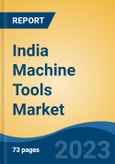Speak directly to the analyst to clarify any post sales queries you may have.
10% Free customizationThis report comes with 10% free customization, enabling you to add data that meets your specific business needs.
Powered by electric, hydraulic, or pneumatic systems, machine tools include devices like lathes, grinders, drill presses, and milling machines. With the integration of computerized numerical control (CNC), modern tools offer enhanced automation, accuracy, and productivity. As India's industrial base continues to grow, machine tools serve as the backbone of precision manufacturing, supporting the production of intricate components and advancing engineering capabilities. They also contribute to higher production efficiency, consistency, and the capability to meet diverse and complex manufacturing demands.
Key Market Drivers
Rapid Industrialization and Infrastructure Development
India’s fast-paced industrial expansion and large-scale infrastructure projects are key forces accelerating the growth of the machine tools market. Rising investments in sectors such as automotive, aerospace, heavy engineering, and railways are fueling the need for high-precision machinery to produce complex and durable components. Infrastructure developments, including smart cities, highways, and industrial corridors, require heavy fabrication, further boosting the demand for efficient machine tools.Initiatives like “Make in India” have attracted domestic and foreign investments, increasing the setup of manufacturing units and consequently the demand for machining solutions. Key industrial states like Tamil Nadu, Maharashtra, Gujarat, and Karnataka are witnessing growth in localized demand, especially from tier-2 and tier-3 cities. The push for defense and aerospace self-reliance has also strengthened demand for high-end equipment. With manufacturing contributing 17-18% to the GDP and the government targeting 25% by 2025, the role of machine tools in supporting industrial productivity and localized manufacturing capabilities is becoming more pronounced across India.
Key Market Challenges
Dependence on Imported Technology and Components
A primary hurdle for the Indian machine tools market is its significant reliance on imported high-precision components and advanced technologies. Despite progress in building a domestic manufacturing ecosystem, critical parts such as CNC systems, high-speed spindles, and cutting-edge sensors continue to be sourced from global suppliers, particularly from the U.S., Japan, and Europe. This dependence results in elevated production costs and exposes Indian manufacturers to supply chain uncertainties and pricing fluctuations.During global disruptions like the COVID-19 pandemic, the vulnerabilities of overreliance on imports became especially evident. Additionally, India's limited R&D capability in specialized automation and digital control systems creates a technological gap, restricting its ability to meet global standards and export high-end machinery. Although some Indian firms are investing in innovation, the current disparity in quality, technology, and scalability remains a challenge. This scenario not only impacts the competitiveness of Indian manufacturers but also constrains the industry's potential for global market penetration.
Key Market Trends
(Not provided in source; omission in accordance with user instructions to select and rephrase only the first subheading under Key Market Trends.)Key Market Players
- DMG Mori Co., Ltd.
- Makino Milling Machine Co., Ltd.
- Haas Automation, Inc.
- Okuma Corporation
- Mazak Corporation (Yamazaki Mazak Corporation)
- Hurco Companies, Inc.
- Doosan Machine Tools Co., Ltd.
- JTEKT Corporation (Koyo Seiko Co., Ltd.)
Report Scope:
In this report, the India Machine Tools Market has been segmented into the following categories, in addition to the industry trends which have also been detailed below:India Machine Tools Market, By Tools Type:
- Metal Cutting Machines
- Metal Forming Machines
India Machine Tools Market, By Technology:
- CNC Machines
- Conventional Machines
India Machine Tools Market, By Application:
- General Purpose Machines
- Special Purpose Machines
India Machine Tools Market, By End User:
- Automotive
- Electrical & Electronics
- Railways
- Consumer Durables
- Government & Defense
- Others
India Machine Tools Market, By Region:
- South India
- North India
- West India
- East India
Competitive Landscape
Company Profiles: Detailed analysis of the major companies present in the India Machine Tools Market.Available Customizations:
With the given market data, the publisher offers customizations according to a company's specific needs. The following customization options are available for the report.Company Information
- Detailed analysis and profiling of additional market players (up to five).
This product will be delivered within 1-3 business days.
Table of Contents
Companies Mentioned
- DMG Mori Co., Ltd.
- Makino Milling Machine Co., Ltd.
- Haas Automation, Inc.
- Okuma Corporation
- Mazak Corporation (Yamazaki Mazak Corporation)
- Hurco Companies, Inc.
- Doosan Machine Tools Co., Ltd.
- JTEKT Corporation (Koyo Seiko Co., Ltd.)








